Author Alexey Aksenov.
The Automotive Club of the Federal Security Service of Russia, which opened its own school of emergency training last year, conducted a two-day winter driving course at a training ground 22 km from Moscow in the city of Staraya Kupavna.
The training ground was designed by Herman Tilke, who gained fame for the construction of Formula 1 racing tracks in Turkey, Bahrain, Malaysia and China. The track, where the drivers of the Special Purpose Garage (GON) train, even has the FIA \u200b\u200bapproval and the right to take Formula 1 tests. In summer, at the training ground, you can simulate winter conditions, thanks to a special coating and dosed water supply.
“However, there is no substitute for real ice or packed snow,” instructors at the FSO school say. In addition, while in summer only certain sections on the track allow you to slip, in winter the entire training ground with a length of more than 600 meters and a width of more than 100 meters turns into a site with perfect ice cover. To maintain it in this condition, every day a special harvesting-and-sweeping machine leaves the track, by the way, with ECX numbers.
Less words...
A short briefing before the start, which explains that the task of the winter course is not to teach how to ride extreme ice and snow, but to show what emergency situations can arise in such conditions, how to deal with them and, most importantly, learn not to get into them.
Landing in a car, regardless of whether it is winter or summer, is one of the main safety criteria. Therefore, classes at the FSO school begin with it. After all, it depends on the landing whether you can do something and how efficiently it can be done in emergency situations.
Correct landing in the car begins with the seat fitting. The chair should be moved away from the steering wheel so that, with outstretched arms, the brush rests on the "steering wheel" at the level of the wrist. This can be adjusted, including using the backrest and steering wheel. At the same time, the driver’s feet, when depressing the brake pedal (or clutch, if any), should remain slightly bent so that in case of an accident, they do not get a fracture. And finally, the hands should always be on the steering wheel at the level of either “at fifteen to three” or without “ten at two”, depending on the type of steering wheel.
The first exercise is a warm-up to warm up and get used to the car. We took a course on front-wheel drive cars - on the Ford Focus of the first generation, which once served in the FSO. Also at the school you can take courses on rear-wheel drive Mercedes-Benz cars and even on the Volga. Or in your own car, which, incidentally, will be cheaper.
So - the snake. Unlike many other schools, here they propose to alternately go through the usual one, that is, when the cones are placed in one line, and immediately after it - with offset cones. This allows you to try both the car and the cover in different modes and then move from simple glides to more complex exercises.
The main principle of movement on a snake on a front-wheel drive car: acceleration, direct steering wheel. Gas discharge to load the front axle, steering wheel turning, the car enters into a bend, we straighten the wheels, press the gas again.
The main mistake of most students is to prematurely press the gas pedal during a turn. On slippery surfaces, this leads to the demolition of the front axle of the machine when it continues to move straight and does not fall into a given trajectory.
Gassing can and should be, but only in cases where the car goes into a deep drift, when "the car’s backside is trying to get ahead." However, in this case too, excessive pressure on the gas will not lead to anything good. It’s ideal to catch the so-called neutral gas, that is, not “to the floor”, but to have traction on wheels. This is being worked out in another exercise, which we will talk about below.
Influenced by ABS
Anti-lock braking system (ABS) is installed on most modern cars. Even Russian automakers have ceased to disdain such a useful feature. However, there is still a myth that the ABS reduces the braking distance. In fact, only systems of the latest generations do not increase it, and a car with old ABSs slowed down longer and further than without them. The main task of the ABS is to maintain controllability during braking, not to block the wheels so that the machine, if necessary, can be stopped and at the same time taken away from the obstacle. But this also needs to be learned.
We accelerate, again on ice, to 60 km / h. Narrow corridor ahead of the obstacle. The task is to brake urgently (the force on the pedal should be maximum) and take the car to another row until it stops.
Even with modern ABS systems, car habits change dramatically. Just turning the steering wheel from an obstacle will not allow you to take the car off the path. When braking, it is necessary to twist the "steering wheel" as if it rotates very hard, that is, applying force, but at the same time smoothly.
But turning a car is half the battle. After rebuilding, the car may enter. Therefore, making a maneuver from an obstacle, it is necessary to turn the steering wheel a little in the direction of the proposed skid (that is, if the car's feed went to the right, then the steering wheel must also be turned in the same direction). But then again, a little and not sharply.
In free flight
The third exercise of the first day of contra-emergency training of the school of the Automotive Club of the Federal Security Service of Russia is riding with a change of skid when driving in a straight line. In principle, in real life such a situation is unlikely to arise. But the task of the exercise is to learn to control the car at high (under 100 km / h) speeds. In this case, it is necessary not only to drive, throwing the car from one side to the other, but to drive in a drift with a constant angle. And just here, when turning the steering wheel, it is necessary to use gas.
Acceleration, under the discharge of gas we direct the car into a skid, counter control, add gas. Moderately not on the floor. The machine begins to slide, accelerate and gradually (as we add gas) level the trajectory. By inertia, the car again goes into a skid, we repeat the same thing, and so seven or eight times.
Generally they say that the third skid is not caught. But with the competent work of gas and steering, repeated repetition of these drifts is possible. Only then will they become controlled.
However, all these flowers are “unpretentious” preparatory exercises to the second day of training.
The truck is not a hindrance
The classic situation in both summer and winter: a car cuts you, an accident happened ahead of you, it would seem that you have nowhere to go. say that in this case you are only obliged to slow down. In part, the recommendation is correct, because an unprepared driver can start to turn the wheel thoughtlessly, which will only aggravate the situation. But if in the summer you slow down you can either get off with a fright or slightly damage your car, then in winter the consequences can be more serious.
At school, the FSO, of course, is not taught to violate traffic rules and is not encouraged to do so. However, being able to get out of such situations is vital.
First, a simple exercise: acceleration, obstacle, detour it and return to its lane.
All winter activities must be completed in advance. If an obstacle occurs, it is necessary to smoothly but quickly turn the steering wheel away from it. The machine will begin to maneuver. And to return to your row, you need to turn the steering wheel in the opposite direction even before the obstacle passes, no matter how wild it sounds. If you are late with this action, you will not have time to return to your ranks.
It is worth remembering that upon returning to his line, the car will “want” to also “wag its tail”, so again it is necessary to use counter-steering. And again, in advance.
And if the obstacle is not a car, and, say, a truck or a bus? It is fraught to stabilize the car after the first maneuver, since it will be more difficult to make another maneuver to return to your lane. And this means that after the first obstacle we begin to slide and, controlling the drift, we return to our row.
The difference with the previous exercise is that after taking the car away from the obstacle, it is necessary to operate the steering wheel so thinly that the car without adding gas passes the entire obstacle sideways and returns to its line.
To explain this in words is impossible. There is no right to make a mistake. Actually, either you do not have time to return to your ranks, starting too early to extinguish the skid, or it turns you around when you are late with the control. Only practice. And I must say, this is one of the most difficult exercises of the course.
We go fast for a “snack”, at 80-90 km / h, along a high-speed snake with shifted cones. An exercise to consolidate the acquired skills. Here you need to think about when to start the maneuver, when to stabilize the car, when to add gas. And here, again, practice is indispensable.
In general, on the recommendation of school instructors, it is necessary to undergo training once every two to three years, at least. Skills persist, but without exercise, muscle memory weakens. In addition to acquiring or reinforcing skills safe driving, you get a huge amount of adrenaline. Well, where else can you slip like that, feel your limit? The city is clearly not suitable for this - only at a specially prepared training ground, and even under the control of the country's best drivers.
A person who has decided to raise the level of his driving knowledge and skills often faces a difficult choice. Where to go? Schools offer their services extreme driving, driving school, driving school ... What is the difference between them? Let's try to figure it out.
Still, there is some logic in the fact that in a country where buying a driver’s license is nowhere more popular, the services of all kinds of extreme driving schools are in great demand. There are a lot of offers on the market and, first of all, it is worth figuring out what the main directions of additional training exist.
So, the first direction is extreme driving schools. This is a collective concept. Under such a loud signboard, the school of emergency driving and courses to improve driving skills can work with equal success. The move is purely marketing. Beautiful name helps attract new customers. However, even one thing leaves its mark on the specifics of schools. Turning here, a person with a high degree of probability will find what is demanded precisely by fans of extreme driving. The emphasis here is on the effect: quick lanes, drifts and trendy police U-turns.
driving-art.ru/
although there are many such schools ... But still, they learn more to show off, and most importantly, do it with the head ... And this is taught already in ...:
The second direction is driving school. They lead their history from training courses for special services drivers. Accordingly, the main task here is to teach a person to properly respond to changing traffic conditions, to feel the car, to competently use vehicle controls. By and large - this is the primary sports training. After passing it, a person, if desired, will take a turn in a controlled drift, and can take part in entry-level car races.
This is the most necessary direction, since there are only a few people who can control the traffic situation. Those who prevent it, even less ... And those who got into it. through no fault of their own, and will be able to get out of an unforeseen situation, preserving the health of others, practically none ...
www.cvvm.ru/
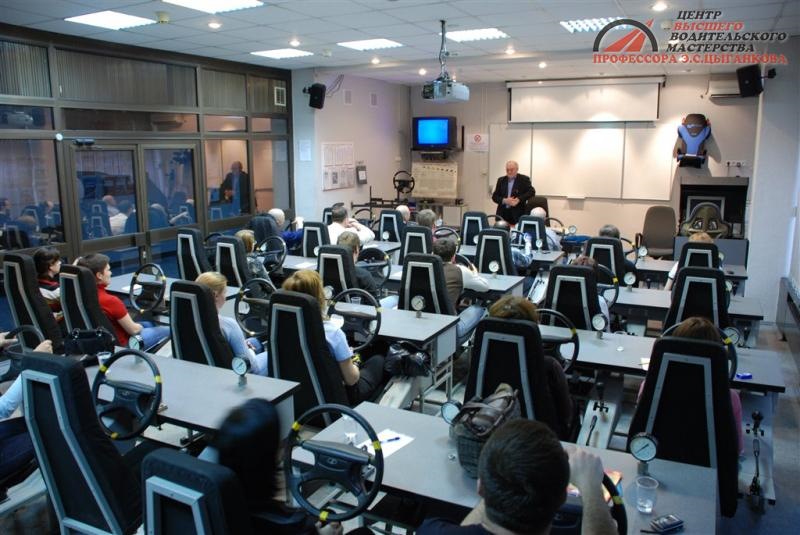
this school is the oldest and most famous in Russia. Most teachers from other schools studied here! Yes, I myself finished the courses in this school! It is not fashionable and modern, it is competent, and the old school!)))
And finally driver training courses. Ideologically, they are close to the second direction, but mainly branded driving schools belong to them. In them you can really take a serious training course, but often it is tied to specific brands, cars and their systems. This also includes specific schools, for example, off-road driving.
Schools: audi quattro school, bmw driving experience and many more ...

The task of schools to improve skills and contra-driving, first of all, is to teach people to drive safely and competently, which means that in addition to the ability to drive a car, you need to talk about driving culture. Based on this, perhaps, it makes sense to somehow control the educational process in institutions such as this happens in ordinary driving schools. This is, after all, as much as the safety of all participants without exception. traffic.
When the first counter-driving school (Ernest Tsygankov) appeared in the Soviet Union, it did not exist by itself. The curriculum was developed jointly with the Ministry of Education, it was closely monitored. And that's why real professionals came out of its walls. At that time, the very existence of three-day courses was impossible, because the specialists perfectly understood that during this time it is impossible to instill the skills acquired by long-term practice. It was a serious training, accessible not to everyone. So, maybe today we should turn to the Soviet experience and stop chasing quantity at the expense of quality. What do you think?
“Experts know that during the Soviet Union, the legendary Seventh and Ninth Directorates of the KGB of the USSR had the highest level of training for operational drivers. Both departments had their own training facilities, methodological and technical training facilities. At the same time, both schools developed in parallel, each had its own style and style. They were determined by the specifics of the tasks, the nature of the service, the experience and vision of the managers responsible for the training.
For employees of the 7th Operational Search Department of the KGB of the USSR, the feature of the work was compliance with conspiracy requirements. This left its mark on the appearance of the car, as well as on the professional training of the driver. Driving a car without proper coloring, light and sound alarms, the need for intensive maneuvering in the traffic stream at the highest possible speed, the ability to quickly and clearly make the only possible decision, the ability to skillfully and competently deviate from the requirements of the rules of the road, identify the facts of harassment and organize the departure from under control - all these are the skills that employees had to master in the learning process.
Employees of the 9th Directorate, providing protection for the first persons of the state, in addition to high driving skills, should have the ability to interact when moving in a convoy, in a motorcade, in an organized group. The specifics of working in direct contact with top officials of the state required knowledge of psychology and etiquette. The employees of both services equally should have mastered the use of service weapons, including in the process of driving.
With the collapse of the Soviet Union, much of what was gained in previous years was lost. Today, as before, driver training in each FSB Service is carried out autonomously, not only lacking competent specialists, but also a healthy competition of teaching methods within the professional community. At the same time, the need for training this class of drivers has been satisfying for many years not only government agencies, but also private organizations. Considering the criminal situation in the country, today the line between the concepts of “personal driver”, “driver-guard” and “operational driver” has practically been erased.
The uniqueness of the training program for personal drivers and security guards of the Shturman Center lies in the synthesis of two training schools for drivers of the Seventh and Ninth Directorates of the KGB of the USSR. The program incorporates the best that was accumulated during the heyday of the KGB. ”
The author is a teacher-consultant of the Center "Navigator". From 1975 to 1989 - Head of special training for drivers of the Special Purpose Garage (GON) ULO SOM FSO, former 9th Directorate of the KGB of the USSR.
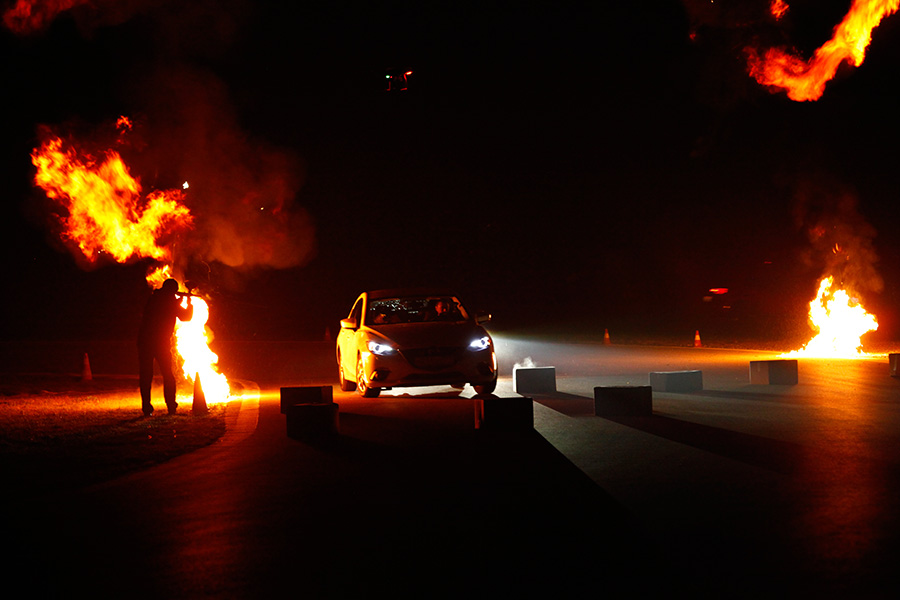
Do not try to repeat, especially on public roads! In late November, I visited the largest Navak test site in the Balkans. There, before entering the local markets, new cars are certified, and drivers are taught to drive cars in extreme conditions. Moreover, both ordinary “civilian” and security guards are trained. I spent only one day at the training ground, not enough for training, but just to understand how it works, just right.
The Navak training ground is located in Serbia, about 60 km from Belgrade. The length of the route is about 3 km. There is also an off-road section at the training ground where car companies conduct crossover test drives, but we came for another one - to try ourselves as security guards-trainees. Cars on which the training took place - brand new restyled "treshki" and "six" Mazda brought from Moscow, the numbers were also Moscow. Before the beginning of the practical part, we were also dedicated to the Japanese driving philosophy of Jinba-Ittai, which means the unity of the driver with the car. To do everything perfectly, you need to feel the car as an extension of yourself.
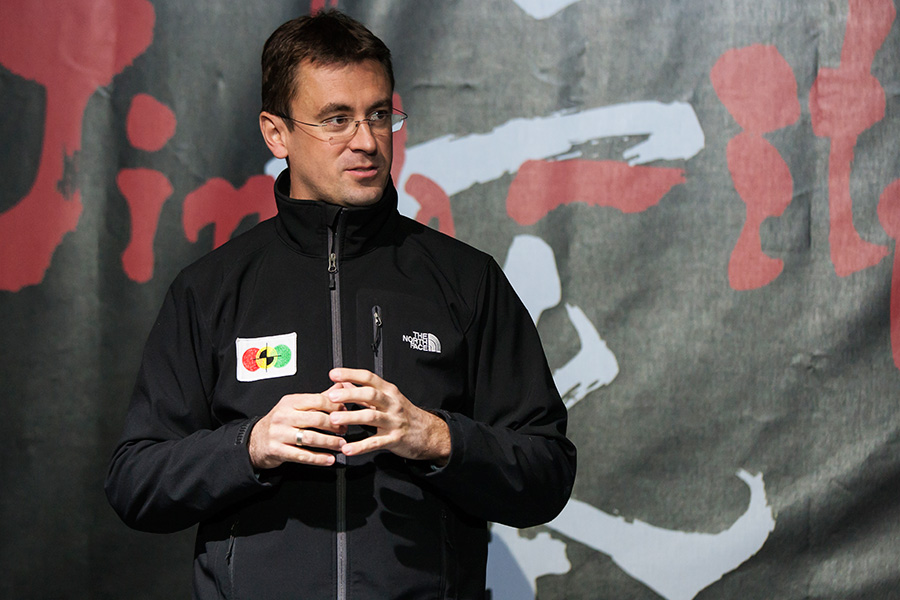
2. Before you get into the car - a mandatory briefing
In total, the participants had to perform five exercises on asphalt from the training program for professional security guards and special services. 20 people were divided into groups and we immediately got one of the most interesting exercises. By the way, I should note that the program was developed by the Serbs. This is not the first time they have hosted Russians, but each time they come up with something new. First you had to push someone else's car off the road.

3. The first exercise, a second before contact 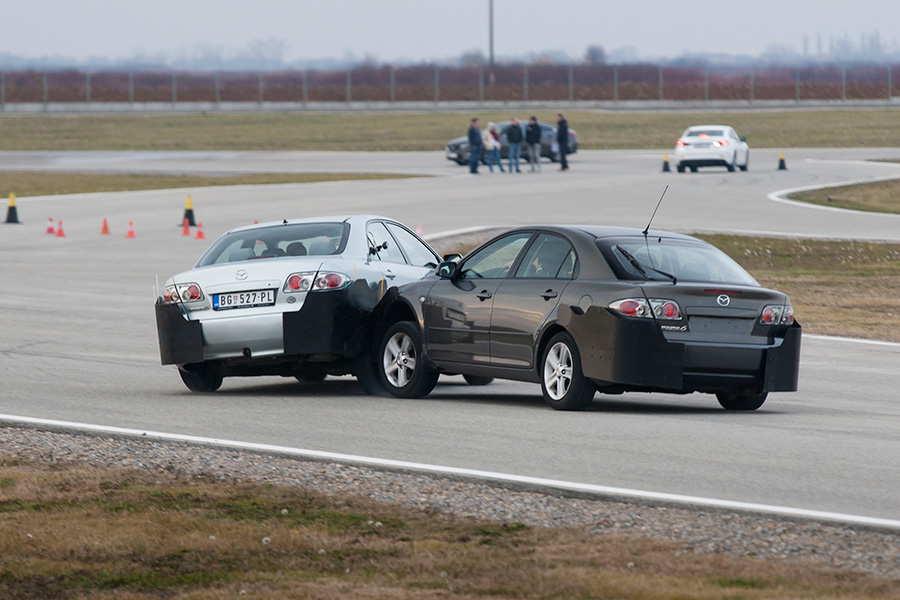
4. Have a contact!
Civil automobiles, on mechanics, from training only wings trimmed with special plates. Previously, they trained without them and the wings had to be changed too often.
Exercise is performed at a speed of 60-65 km / h. In principle, there is nothing complicated in it. It is necessary to catch up with the car in front, equalize the speed, attach itself with the left front wing close to the rear right wing of the car being knocked off the track, and then smoothly turn the steering wheel to the left, while pressing the gas pedal. The victim flies off the road “with a bang”, the main thing is not to turn the steering wheel sharply (otherwise you will fly off to the side of the road), do not start aligning the wheels immediately after contact (bump into another car) and do not remove your foot from the gas pedal. A very good exercise in order to understand how easy it is to arrange a serious accident and how little is needed for the car to flew to the side of the road or to the oncoming lane after a light touch.
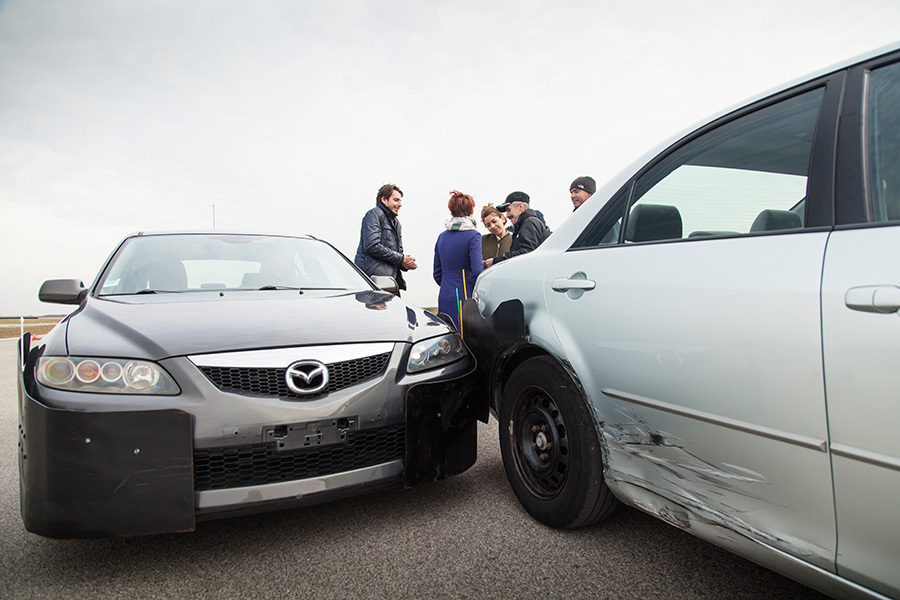
5. The consequences of training
The second exercise was a police U-turn. True, the task was somewhat complicated, on a Mazda3 with an automatic machine it was first necessary to write out a figure of eight, each turn in which was carried out with the help of a hand brake, and then also stand in a police garage bounded by cones. Everything is also simple, in manual mode, in second gear, at a speed of 40-45 km / h you drive up to the cone, lightly brake the brake pedal to load the front wheels of the car and unload the rear ones, then you pull on the handbrake, go through the turn, lower the handbrake and give gas to have time to accelerate before the next turn.
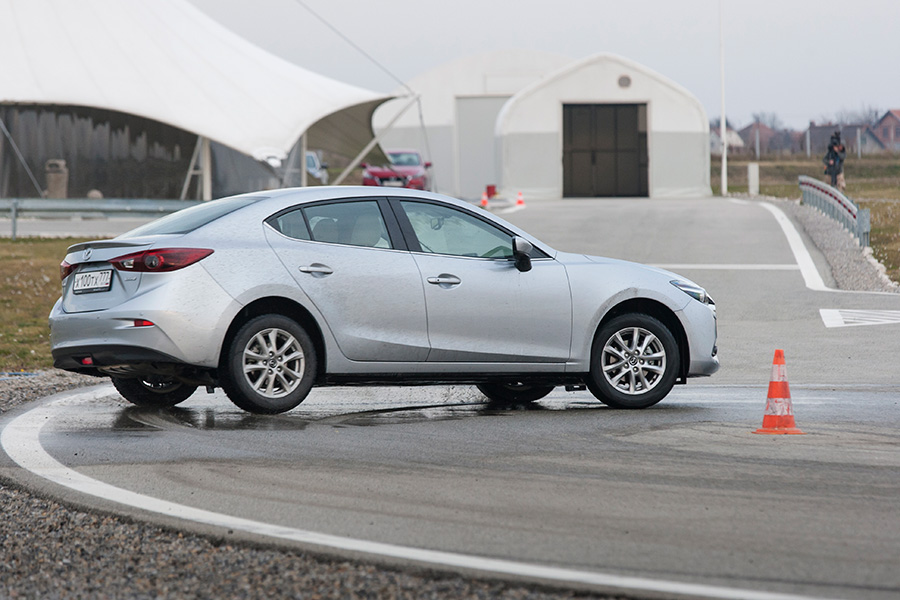
6. Police U-Turn 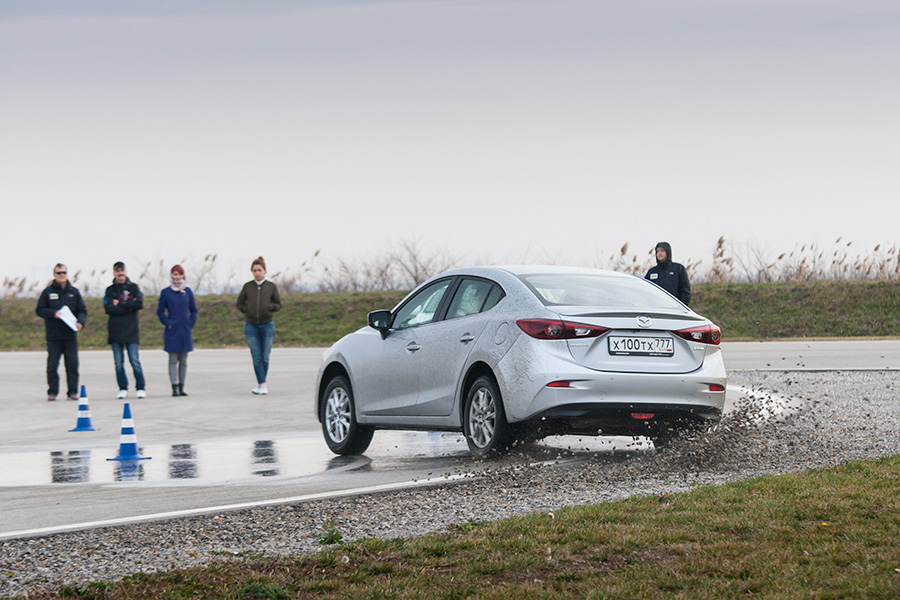
7. Doesn't fit
The third exercise was a snake at a speed of 60-65 km / h (the distance to the cones no longer allowed to disperse). It was necessary to move with an obligatory skid of an axis in each turn. It was important here to operate the steering wheel sharply, but not to turn it too much, load the front axle before each turn, while unloading the rear axle, and remember to press the gas so as not to lose speed. Without gas, the car stopped on the third cone, and there were five in all.
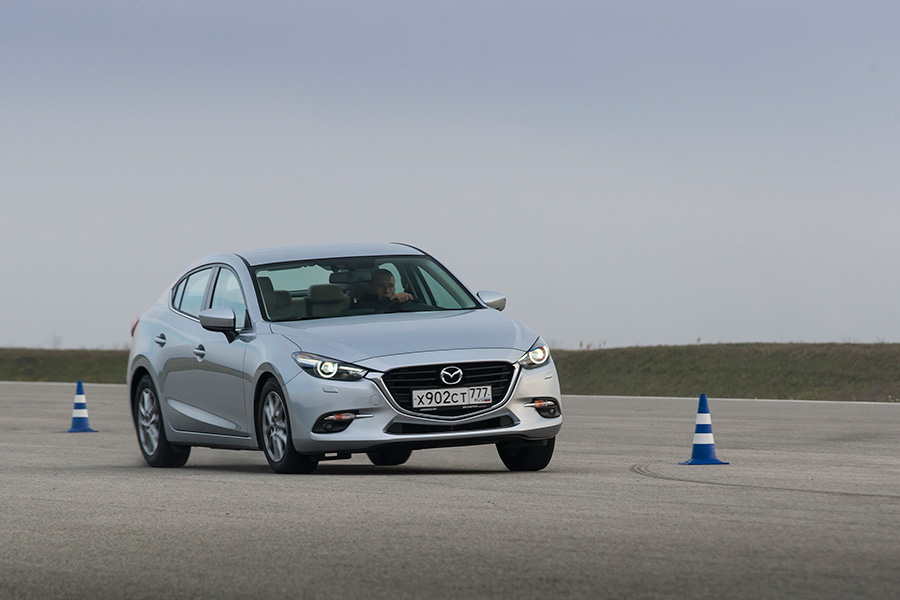
8. A snake with a skid 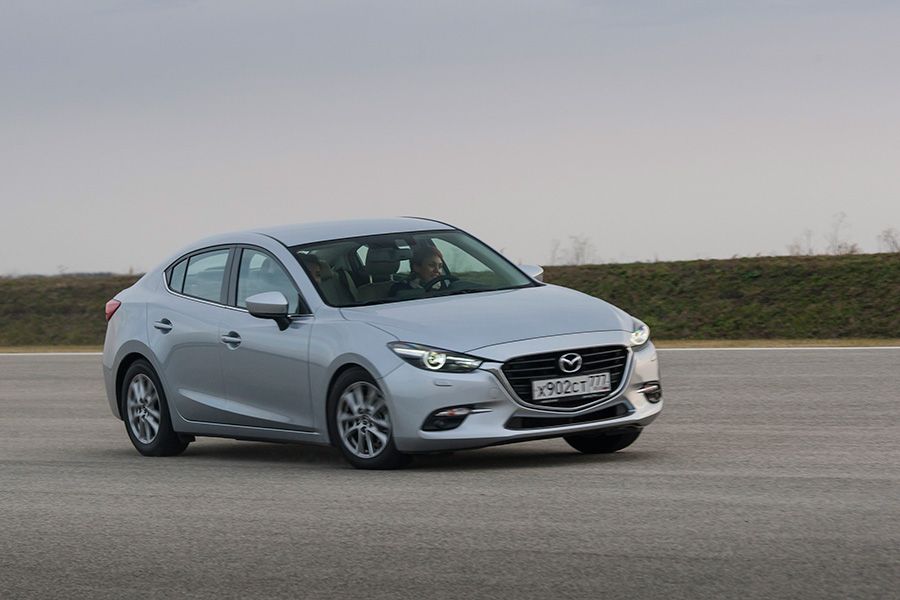
9. She is 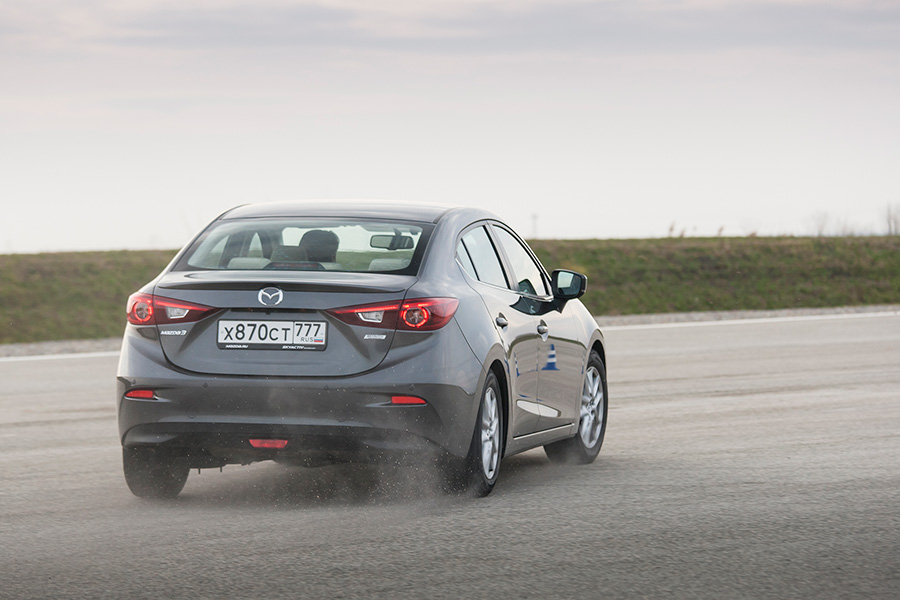
10. And another perspective
The fourth exercise is a 180-degree turn without braking on the Mazda6 with a gun. You accelerate backwards to the highest possible speed, switch to neutral, sharply turn the steering wheel to the left, after the car makes a half turn, you start to turn the steering wheel in the opposite direction, turn on the “drive” and press on the gas. It is important to carefully switch the machine so as not to get into the drive instead of neutral immediately and not to kill the box.

11. Fourth exercise, backward movement and U-turn. Last instructions 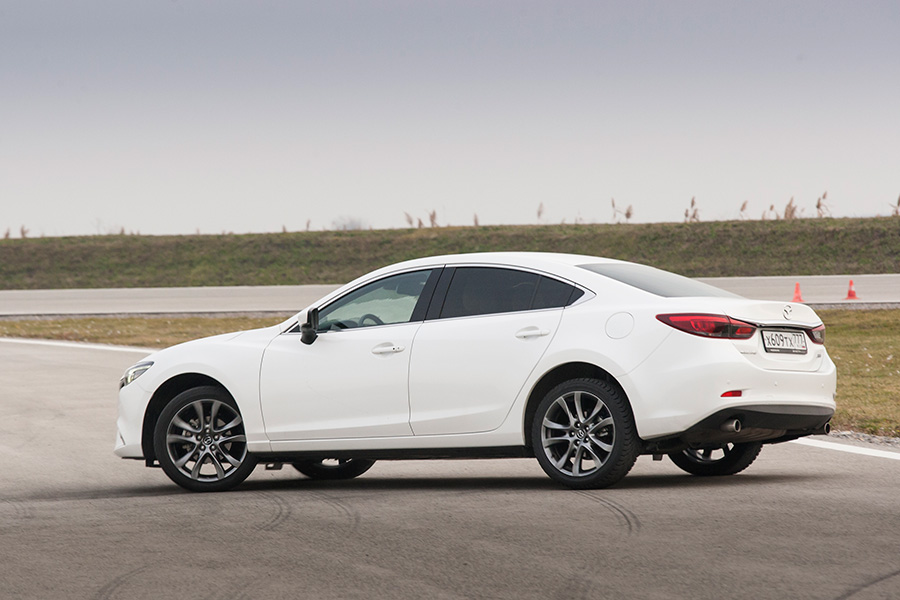
12. The photo does not look very spectacular, it was necessary to shoot a video
The fifth exercise was the most exciting. It was carried out on two "sixes", the first - with a VIP-person, and the second - a security car. They are chased by "terrorists" with a gun for paintball. Their role was played by professional Navak instructors. Cars must move so that none of the "bullets" hit the VIP-car. The recommended speed was still the same - 60-65 km / h, but we performed it at a speed of 80-90 km / h. In the role of a VIP car, I caught a few bullets, but I acted better as a security car. In retaliation after the exercise, the "terrorists" overtook me and, under general laughter, planted several bullets in the windshield.

13. Instructors work with pleasure 
14. The fifth exercise - cover the boss from bullets 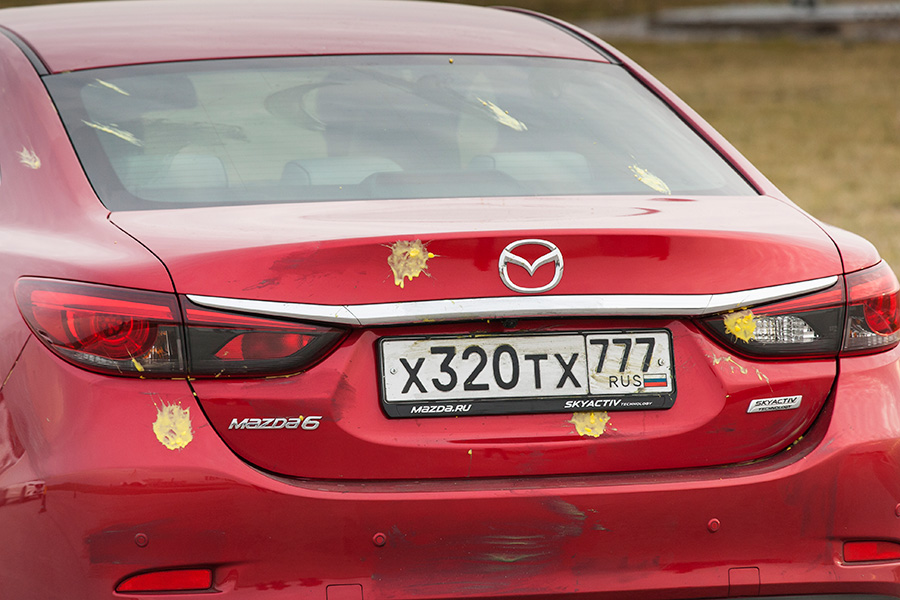
15. Traces of bullets
It is clear that the most spectacular exercises were chosen for us, and in preparing professional security guards, they are faced with much more tasks. But these tasks give an idea of \u200b\u200bhow the training goes. Nothing complicated, but everything should be worked out to automaticity, preferably on cars with different types of boxes. Such work costs a lot of money, cars are tacked very quickly, especially when unprepared drivers get behind the wheel. Winter tires on some cars were completely killed. By the way, now I have the same machine on a test in Moscow as it was at the training ground in Serbia. This is the last test drive in the past year. Then a two-week break for New Year's frenzy on the roads and Toyota Land Cruiser 200 Executive Black just before the New Year. But this is the story of 2017.
I will continue the story of the adventures at the Navak training ground. Yes, they didn’t end with five exercises. After all, it is important not only to learn how to turn around on the spot or avoid chasing in sterile conditions, but also to apply these skills in practice, and under aggravating circumstances. For us, the organizers used the darkness as such a circumstance.

16. This is what the exam looked like
They waited until sunset and asked us to demonstrate what we were taught. Each team was given three cars - one with a VIP client and two for security. It was necessary to drive along the highway to the only illuminated area where the VIP would take a selfie, and then drive to the finish. At the same time, we were informed that they would shoot at the main car, but they didn’t say who and where, but there would be obstacles on the highway. To evaluate the result, the time and the number of hits in the main machine were used. I just controlled her. I must say that I was the least hit, and we showed the second time, 6 seconds behind the leader. You could have won, but the VIP from my car took selfies for too long. Four photos! But what do you take from a girl. They shot at us from two cars, some pyrotechnics exploded on the side of the road, blocks were put up in one place after the turn, which we had to overcome with the help of a police turn. But we were smart and squeezed near the extreme block along the edge of the road.

17. Selfie stop
The result of a trip to Belgrade was new interesting skills. It is clear that greenhouse conditions have been created for us. For example, in the first exercise, where it was necessary to push the car off the road, an instructor was sitting at the wheel of it, who at least did not interfere with learning. If he avoided a collision, pushing him would be much more difficult. In general, the work of professional security guards is not easy, but the training is interesting.
I will add that a trip to the Navak training ground was the rare case when I put the camera aside and focused solely on driving, and for the post I used the official shooting, kindly provided by the trip organizer - the Russian representative office of Mazda.


